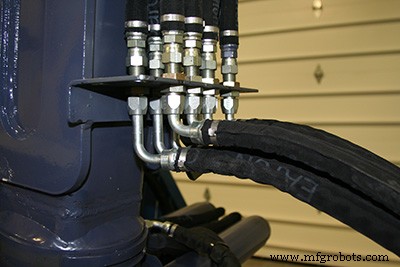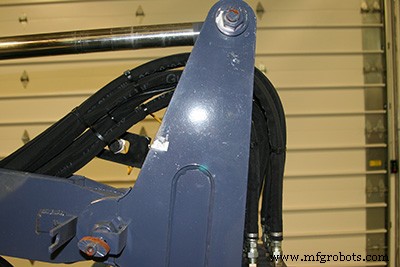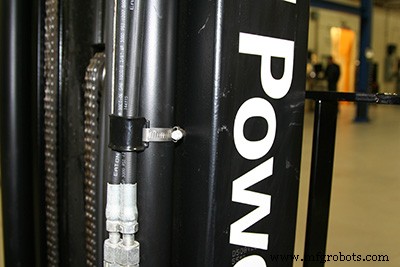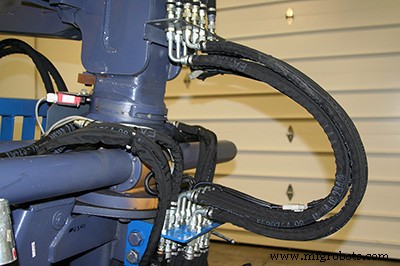10 dicas para facilitar o projeto e a manutenção de mangueiras hidráulicas
Na parte 2 desta série de três partes, o autor discutirá como a tubulação e o roteamento da mangueira podem simplificar a manutenção e reduzir a falha da mangueira. Leia a parte 1 e a parte 3 aqui.

Para direcionar e instalar corretamente os componentes de transporte de fluido durante a prototipagem de uma máquina, siga estas 10 regras gerais. Essas diretrizes são mais úteis durante a prototipagem da máquina. Os procedimentos normais de produção devem ser seguidos após a remoção de todos os “bugs”.
- Comece com linhas grandes — Instale primeiro as maiores linhas ID, pois são as mais difíceis de dobrar e manobrar, especialmente em espaços apertados. Então, a parte mais difícil do trabalho é feita. Linhas menores fornecem mais versatilidade de roteamento e podem ser mais facilmente trabalhadas em espaços apertados, então roteie cada linha para economizar o máximo de espaço. Isso não apenas resulta em uma instalação de aparência mais organizada, mas também torna as futuras modificações ou acréscimos de acessórios mais fáceis, mais convenientes e mais econômicos.
- Comprimento correto da mangueira — A aparência e a operação eficiente de um sistema geralmente dependem do uso de mangueiras de comprimento adequado. O tamanho excessivo da mangueira aumenta as quedas de pressão e o custo do sistema. Conjuntos de mangueiras são comumente fabricados em comprimentos especificados, bem como incrementos de comprimentos para minimizar o tamanho do estoque, que deve ser transportado. Ao calcular o comprimento da mangueira, lembre-se de que a mangueira pode alongar até 2% ou contrair até 4%.
- Flexibilidade da mangueira — Um conjunto de mangueira é projetado para flexionar ou dobrar, não torcer. De fato, se uma mangueira de alta pressão de grande diâmetro for torcida 7°, sua vida útil pode ser significativamente reduzida, em alguns casos em até 90%. A mangueira de alta pressão deve ser direcionada para flexionar em apenas um plano. If plumbing requires that hose be routed through a compound bend, the hose should be “broken” into two or more sections so each will flex through only one plane. A spring guard will keep hose from bending beyond the minimum bend radius at the fitting, but it will not prevent the hose from twisting.
-

Pivot points — When hose must flex, route it through the pivot point around which the component is moving. This will result in the best and most efficient flexing of the hose line, use the least amount of hose and keep the hose within the contour of the machine. To achieve this, the hose should be positioned to bend like a hinge. Otherwise, the hose may have a tendency to take an S-bend, which is most likely to happen when the hose is pushed rather than bent. An S-bend installation results in excessive hose movement and reduced service life. When piping a flexible line through a pivot point, consider the relative positioning of the two end fittings to avoid an S-bend by following this procedure:Swing the moving component to its farthest point where the hose will experience its widest bend. If the fittings are placed in parallel planes at this point, the hose will tend to flex in a hinge-like manner when the component is swung back to the opposite end of its travel. - Reciprocating motion — In addition to flexing, the ends of the hose may have to reciprocate. There are several design methods to do this:
- Hose reels — For use with high-pressure hydraulic hose, these reels are equipped with high-pressure swivel joints and a spring return to help rewind the hose.
- Festooning — Hose is hung in loops from a steel cable. As one point of the loop moves away from the other, the loops open to form an almost straight line.
- Rolling — Hose is arranged in an unbalanced U-shape with hinged tracks carrying the hose. One leg is left stationary and longer than the second, which is free to reciprocate parallel to the first.
-

Rotary motion — Swivel or rotary joints are commonly used to provide rotating motion. Where rotary movement is a continuous 360°, use a rotary joint. If movement is reversing, a swivel joint would be the better choice. When used with hose, a swivel joint will avoid hose twisting or bending at the fitting. - Control oil spray — Fire protection must be used where hydraulic lines are routed near hot, potentially hazardous areas. This prevents oil from a broken line from spraying onto any potential source of ignition. There are several ways to accomplish this:
- Reroute the line through a tunnel made from steel tubing, channel, or angle iron.
- Install a sheet-metal baffle between the lines and potential ignition source.
- Route the lines through a large, open-ended hose or sleeve so the oil will flow out of the ends in case of line failure.
- Use fire sleeves either to fit over the hose or built into the hose cover.
- To guard against a failed hose that might whip and spray hydraulic oil over an ignition source, anchor the hose to the component to which it is hydraulically connected.
- Minimum bend radii — The hose must be routed to accommodate the minimum bend radii of that hose. Minimum bend radii for various size hoses can be found in SAE
specifications and hose manufacturers’ catalogs. These figures usually refer to the minimum bend radius at maximum operating pressure for a static line. Exceeding the minimum
bend radius can result in kinking of the hose and/or most likely, extra stress at the hose or fitting interface. This causes the cover to become more easily cracked or the internal wire reinforcement to fatigue quicker, both of which will reduce service life. -

Avoid abrasion — Most hydraulic hose is built with a tough outer cover to protect the hose reinforcement from abrasion or moisture damage. However, constant abrasion at one point will eventually puncture the outer cover and weaken the reinforcement. This is the number one cause of hydraulic hose failures in the field. To avoid abrasion as much as possible, properly route and clamp the hose or use a protective cover. Choose from a variety of protective coverings:
- Coiled springs
- Spiraled plastic
- Coiled strap steel
- Nylon sleeves
- Clamping — A piping installation is not complete until it has been properly clamped. Clamp choice is very important, and often it can be critical to the installation. Common sheet metal clamps will not hold a large, high-pressure hose.Good clamps can be inexpensive, yet highly effective for high-pressure surge lines. Anticipate and plan for a possible length change ranging from an increase of 2% to a decrease of 4% for high-pressure lines. Properly sized clamps should grip the hose in a positive manner. To keep the clamp from abrading the hose, the ID of the clamp should be about 1⁄32 in. smaller than the OD of the hose.
Good installation techniques are essential to efficient operation and obtaining the maximum life of a hydraulic system. However, hydraulic hose and tubing are fatigue items with a finite service life. Eventually these wear items will fail. Typically, basic maintenance techniques are not enough to sufficiently prevent failures from occurring, whether it be visual inspection or time-based preventive schedules.
Eaton Corp.
eaton.com
Equipamento industrial
- 5 dicas para design de chapas metálicas
- Dicas do operador da escavadeira para abertura de valas e carregamento
- Práticas recomendadas e dicas de manutenção para sistemas hidráulicos
- 5 dicas de segurança e manutenção para a talha de corrente do seu guindaste
- 5 Dicas para Manutenção de Acoplamentos Industriais
- 3 dicas de manutenção de segurança para talhas de corrente de guindaste
- Dicas para manutenção de sistemas de perfuração hidráulica industrial
- Três dicas para manutenção de equipamentos industriais
- Manutenção de máquinas:definição e dicas
- Dicas para melhorar os programas de manutenção



